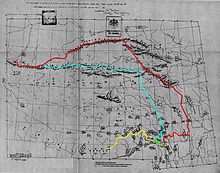Shimla Convention
The Shimla Convention (also Simla Convention ) was agreed between Great Britain , China and Tibet in Shimla in 1914 . China has not ratified this international law and treaty binding convention .
content
The convention provided that
- Great Britain and China recognize the sovereignty ( suzerainty ) of China over Tibet,
- the "outer" Tibet (roughly today's Qinghai region and areas to the east of it) should remain under direct Chinese rule,
- "Inner" Tibet (today's Tibet region) should be autonomous and that China should not interfere in its internal affairs:
- China refrains from interfering with the Tibetan administration
- Election of the Dalai Lama continues to be done by the administration in Lhasa
- China must safeguard the country's territorial integrity
- China does not deploy a military
- Representatives, officials of China and Chinese settlers are not sent
- if they are present in the designated area, they must be withdrawn within three months.
In addition, the border between British India and Tibet was set along the McMahon Line , which significantly shifted the British Indian border to the north. The newly reclaimed area was organized by the British colonial government as the North-East Frontier Tracts .
Another story
The convention was rejected by China and the Chinese agent Ivan Chen left Simla on July 3, 1914 without having signed. The remaining Tibetan and British negotiating partners then concluded a bilateral agreement. However, the agreement was initially rejected by the British Indian government because it contradicted the Treaty of Saint Petersburg (1907) or the Anglo-Russian Convention (1907) , in which Great Britain and Russia had coordinated their spheres of interest in Asia. It was not until the 1930s that the British began to depict the McMahon Line as the British-India border in official documents.
China never recognized this border and in the Indo-Chinese Border War of 1962 , troops of the People's Republic of China advanced via the McMahorn Line to India , but then withdrew behind it.
See also
Web links
- Shimla Convention (English)

